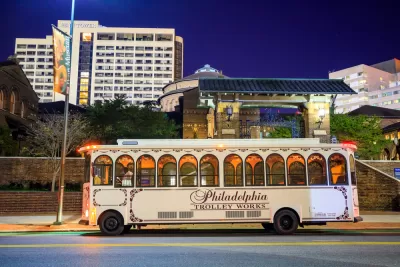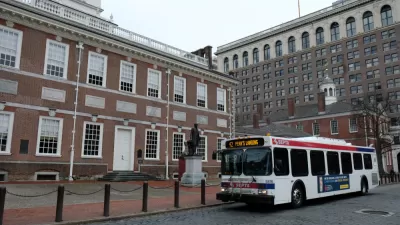The plan, which looks more than two decades into the future, seeks to modernize the city's transit system, address inequities, and improve regional connectivity.

Philadelphia officials unveiled an ambitious 24-year plan for the city's transit system that "aims to improve the system while addressing long-standing racial inequities through a redesigned bus network and Regional Rail service, modernized trolleys, and increased accessibility across the system." The plan, reports Darryl C. Murphy for WHYY, includes both current projects and "aspirational" but as-yet-unfunded ideas.
Philadelphia Deputy Managing Director for Transportation Michael Carroll said the plan "will help the city and [the Southeastern Pennsylvania Transportation Authority] compete for federal grants and align projects in a challenging post-pandemic economic landscape" while addressing the legacy of historical inequities in the city's transportation policies. "For instance, residents of color face commutes that are on average 12 minutes longer than white residents," and low-income commuters spend more on transit "because of transfer fees and connectivity challenges in neighborhoods outside of the city’s downtown core," writes Murphy. A restructured fare plan introduced by SEPTA last year seeks to address these issues and make the system more affordable.
"The plan unveiled Monday includes 30 corridors for improvements such as bus lanes, transit priority signals, and boarding islands to speed up bus service as options" and highlights the importance of Regional Rail. "This isn’t just about connecting suburban commuters downtown. More than 40% of Philadelphians work outside of the city," says City Councilmember Cherelle Parker in the article. The plan, which involved collaboration from multiple agencies and community groups, could signal a new level of regional cooperation.
FULL STORY: Faster buses, more Regional Rail, modern trolleys: Philly’s transit plan takes system to 2045

Maui's Vacation Rental Debate Turns Ugly
Verbal attacks, misinformation campaigns and fistfights plague a high-stakes debate to convert thousands of vacation rentals into long-term housing.

Planetizen Federal Action Tracker
A weekly monitor of how Trump’s orders and actions are impacting planners and planning in America.

In Urban Planning, AI Prompting Could be the New Design Thinking
Creativity has long been key to great urban design. What if we see AI as our new creative partner?

Massachusetts Budget Helps Close MBTA Budget Gap
The budget signed by Gov. Maura Healey includes $470 million in MBTA funding for the next fiscal year.

Milwaukee Launches Vision Zero Plan
Seven years after the city signed its Complete Streets Policy, the city is doubling down on its efforts to eliminate traffic deaths.

Portland Raises Parking Fees to Pay for Street Maintenance
The city is struggling to bridge a massive budget gap at the Bureau of Transportation, which largely depleted its reserves during the Civd-19 pandemic.
Urban Design for Planners 1: Software Tools
This six-course series explores essential urban design concepts using open source software and equips planners with the tools they need to participate fully in the urban design process.
Planning for Universal Design
Learn the tools for implementing Universal Design in planning regulations.
Gallatin County Department of Planning & Community Development
Heyer Gruel & Associates PA
JM Goldson LLC
City of Camden Redevelopment Agency
City of Astoria
Transportation Research & Education Center (TREC) at Portland State University
Jefferson Parish Government
Camden Redevelopment Agency
City of Claremont





























